3D Printing and Implementation of Digital Twins: Current Trends and Limitations
Abstract
:1. Introduction
2. Current Digital Twin Applications in 3D Printing Technologies
3. Practical Issues in Accordance with Procedure Needs
3.1. In Situ Monitoring
3.2. Valid Forecast of the 3D Printing Procedure Results
4. Conclusions
Funding
Institutional Review Board Statement
Informed Consent Statement
Data Availability Statement
Conflicts of Interest
Nomenclature
| DT | Digital Twin |
| AI | Artificial Intelligence |
| ML | Machine Learning |
| DL | Deep Learning |
| CNN | Convolutional Neural Network |
| NN | Neural Network |
References
- Kostakis, V.; Papachristou, M. Commons-based peer production and digital fabrication: The case of a RepRap-based, Lego-built 3D printing-milling machine. Telemat. Inform. 2014, 31, 434–443. [Google Scholar] [CrossRef]
- Kantaros, A.; Piromalis, D. Employing a Low-Cost Desktop 3D Printer: Challenges, and How to Overcome Them by Tuning Key Process Parameters. Int. J. Mech. Appl. 2021, 10, 11–19. [Google Scholar] [CrossRef]
- Kantaros, A.; Diegel, O. 3D printing technology in musical instrument research: Reviewing the potential. Rapid Prototyp. J. 2018, 24, 1511–1523. [Google Scholar] [CrossRef]
- Kantaros, A.; Piromalis, D. Fabricating Lattice Structures via 3D Printing: The Case of Porous Bio-Engineered Scaffolds. Appl. Mech. 2021, 2, 289–302. [Google Scholar] [CrossRef]
- Kantaros, A.; Diegel, O.; Piromalis, D.; Tsaramirsis, G.; Khadidos, A.O.; Khadidos, A.O.; Khan, F.Q.; Jan, S. 3D printing: Making an innovative technology widely accessible through makerspaces and outsourced services. Mater. Today Proc. 2021, 49, 2712–2723. [Google Scholar] [CrossRef]
- Gadagi, B.; Lekurwale, R. A review on advances in 3D metal printing. Mater. Today Proc. 2021, 45, 277–283. [Google Scholar] [CrossRef]
- Liao, J.; Shen, Z.; Xiong, G.; Liu, C.; Luo, C.; Lu, J. Preliminary Study on Fault Diagnosis and Intelligent Learning of Fused Deposition Modeling (FDM) 3D Printer. In Proceedings of the14th IEEE Conference on Industrial Electronics and Applications (ICIEA), Xi’an, China, 19–21 June 2019; pp. 2098–2102. [Google Scholar] [CrossRef]
- Kantaros, A.; Laskaris, N.; Piromalis, D.; Ganetsos, T. Manufacturing Zero-Waste COVID-19 Personal Protection Equipment: A Case Study of Utilizing 3D Printing While Employing Waste Material Recycling. Circ. Econ. Sust. 2021, 1, 851–869. [Google Scholar] [CrossRef]
- Song, R.; Telenko, C. Material waste of commercial FDM printers under realistic conditions. In Proceedings of the 26th Annual International Solid Freeform Fabrication Symposium, Austin, TX, USA., 10–12 August 2015. [Google Scholar]
- Kantaros, A.; Giannatsis, J.; Karalekas, D. A novel strategy for the incorporation of optical sensors in Fused Deposition Modeling parts. In Proceedings of the International Conference on Advanced Manufacturing Engineering and Technologies, Stockolm, Sweden, 27–30 October 2013; Universitets Service US AB, KTH Royal Institite of Technology: Stockholm, Sweden, 2013. ISBN 978-91-7501-893-5. [Google Scholar]
- Kantaros, A.; Karalekas, D. FBG Based in Situ Characterization of Residual Strains in FDM Process. In Residual Stress, Thermomechanics & Infrared Imaging, Hybrid Techniques and Inverse Problems; Rossi, M., Sasso, M., Connesson, N., Singh, R., DeWald, A., Backman, D., Gloeckner, P., Eds.; Conference Proceedings of the Society for Experimental Mechanics Series; Springer International Publishing: Cham, Switzerland, 2014; Volume 8, pp. 333–337. [Google Scholar]
- Kantaros, A.; Karalekas, D. Fiber Bragg Grating Based Investigation of Residual Strains in ABS Parts Fabricated by Fused Deposition Modeling. Process. Mater. Des. 2013, 50, 44–50. [Google Scholar] [CrossRef]
- DebRoy, T.; Zhang, W.; Turner, J.; Babu, S.S. Building digital twins of 3D printing machines. Scr. Mater. 2017, 135, 119–124. [Google Scholar] [CrossRef]
- Holzmond, O.; Li, X. In situ real time defect detection of 3D printed parts. Addit. Manuf. 2017, 17, 135–142. [Google Scholar] [CrossRef]
- Tlegenov, Y.; Hong, G.S.; Lu, W.F. Nozzle condition monitoring in 3D printing. Robot. Comput.-Integr. Manuf. 2018, 54, 45–55. [Google Scholar] [CrossRef]
- Kazemian, A.; Khoshnevis, B. Real-time extrusion quality monitoring techniques for construction 3D printing. Constr. Build. Mater. 2021, 303, 124520. [Google Scholar] [CrossRef]
- Wang, B.; Tao, F.; Fang, X.; Liu, C.; Liu, Y.; Freiheit, T. Smart Manufacturing and Intelligent Manufacturing: A Comparative Review. Engineering 2021, 7, 738–757. [Google Scholar] [CrossRef]
- Goodfellow, I.; Bengio, Y.; Courville, A. Deep Learning. 2016. Available online: https://www.deeplearningbook.org (accessed on 15 December 2021).
- Fahle, S.; Prinz, C.; Kuhlenkötter, B. Systematic review on machine learning (ML) methods for manufacturing processes–Identifying artificial intelligence (AI) methods for field application. Procedia CIRP 2020, 93, 413–418. [Google Scholar] [CrossRef]
- Ma, L.; Xie, W.; Zhang, Y. Blister Defect Detection Based on Convolutional Neural Network for Polymer Lithium-Ion Battery. Appl. Sci. 2019, 9, 1085. [Google Scholar] [CrossRef] [Green Version]
- Lavrik, E.; Panasenko, I.; Schmidt, H.R. Advanced Methods for the Optical Quality Assurance of Silicon Sensors. Nucl. Instrum. Methods Phys. Res. Sect. A Accel. Spectrometers Detect. Assoc. Equip. 2019, 922, 336–344. [Google Scholar] [CrossRef] [Green Version]
- Hermann, M.; Pentek, T.; Otto, B. Design Principles for Industrie 4.0 Scenarios. In Proceedings of the 49th Hawaii International Conference on System Sciences, Koloa, HI, USA, 5–8 January 2016; pp. 3928–3937. [Google Scholar] [CrossRef] [Green Version]
- Jasperneite, J. Was hinter Begriffen wie Industrie 4.0 steckt. Comput. Autom. 2012, 12, 24–28. [Google Scholar]
- Kagermann, H.; Wahlster, W.; Helbig, J. Recommendations for Implementing the Strategic Initiative Industrie 4.0: Final Report of the Industrie 4.0 Working Group. 2013. Available online: https://www.researchgate.net/publication/307864150_Design_Principles_for_Industrie_40_Scenarios_A_Literature_Review (accessed on 30 December 2021).
- Lasi, H.; Fettke, P.; Kemper, H.G.; Feld, T.; Hoffmann, M. Industry 4.0. Bus. Inf. Syst. Eng. 2014, 6, 239–242. [Google Scholar] [CrossRef]
- Marr, B. Why Everyone Must Get Ready for the 4th Industrial Revolution, Forbes. Available online: https://www.forbes.com/sites/bernardmarr/2016/04/05/why-everyone-must-get-ready-for-4th-industrial-revolution/?sh=334428813f90 (accessed on 15 December 2021).
- Schwab, K. The Fourth Industrial Revolution: What It Means, How to Respond. Available online: https://www.weforum.org/agenda/2016/01/the-fourth-industrial-revolution-what-it-means-and-how-to-respond/ (accessed on 15 December 2021).
- Schwab, K.; Frølund, L.; Riedel, M.F. (Eds.) Strategic Industry-University Partnerships; Elsevier: Amsterdam, The Netherlands, 2018; pp. xvii–xviii. ISBN 9780128109892. [Google Scholar] [CrossRef]
- Schwab, K. The Fourth Industrial Revolution; Currency Press: London, UK, 2018; ISBN 9781524758868. [Google Scholar]
- Schwab, K.; Davis, N. Shaping the Fourth Industrial Revolution; World Economic Forum: Geneva, Switzerland, 2018; ISBN1 -10: 1944835148. ISBN2 -13: 978-1944835149. [Google Scholar]
- Schwab, K. Globalization 4.0: A New Architecture for the Fourth Industrial Revolution. Foreign Affairs. 2019. Available online: https://www.foreignaffairs.com/articles/world/2019-01-16/globalization-40 (accessed on 23 December 2021).
- Stark, R.; Fresemann, C.; Lindow, K. Development and operation of Digital Twins for technical systems and services. CIRP Ann. 2019, 68, 129–132. [Google Scholar] [CrossRef]
- Schleich, B.; Anwer, N.; Mathieu, L.; Wartzack, S. Shaping the digital twin for design and production engineering. CIRP Ann. 2017, 66, 141–144. [Google Scholar] [CrossRef] [Green Version]
- Mukherjee, T.; DebRoy, T. A digital twin for rapid qualification of 3D printed metallic components. Appl. Mater. Today 2019, 14, 59–65. [Google Scholar] [CrossRef]
- Qi, Q.; Tao, F.; Zuo, F.; Zhao, D. Digital Twin Service towards Smart Manufacturing. Procedia CIRP 2017, 72, 237–242. [Google Scholar] [CrossRef]
- Cimino, C.; Ferretti, G.; Leva, A. Harmonising and integrating the Digital Twins multiverse: A paradigm and a toolset proposal. Comput. Ind. 2021, 132, 103501. [Google Scholar] [CrossRef]
- Van Der Horn, E.; Mahadevan, S. Digital Twin: Generalization, characterization and implementation. Decis. Support Syst. 2021, 145, 113524. [Google Scholar] [CrossRef]
- Semeraro, C.; Lezoche, M.; Panetto, H.; Dassisti, M. Digital twin paradigm: A systematic literature review. Comput. Ind. 2021, 130, 103469. [Google Scholar] [CrossRef]
- Al-Darraji, I.; Piromalis, D.; Kakei, A.A.; Khan, F.; Stojmenovic, M.; Tsaramirsis, G.; Papageorgas, P. Adaptive Robust Controller Design-Based RBF Neural Network for Aerial Robot Arm Model. Electronics 2021, 10, 831. [Google Scholar] [CrossRef]
- Al-Darraji, I.; Derbali, M.; Tsaramirsis, G. Tilting-rotors Quadcopters: A New Dynamics Modelling and Simulation based on the Newton-Euler Method with Lead Compensator Control. In Proceedings of the 2021 8th International Conference on Computing for Sustainable Global Development (INDIACom), New Delhi, India, 17–19 March 2021; pp. 363–369. [Google Scholar] [CrossRef]
- Dong, Y.; Tan, R.; Zhang, P.; Peng, Q.; Shao, P. Product redesign using functional backtrack with digital twin. Adv. Eng. Inform. 2021, 49, 101361. [Google Scholar] [CrossRef]
- Ghosh, A.K.; Sharif Ullah, A.; Teti, R.; Kubo, A. Developing sensor signal-based digital twins for intelligent machine tools. J. Ind. Inf. Integr. 2021, 24, 100242. [Google Scholar] [CrossRef]
- Singh, M.; Fuenmayor, E.; Hinchy, E.P.; Qiao, Y.; Murray, N.; Devine, D. Digital Twin: Origin to Future. Appl. Syst. Innov. 2021, 4, 36. [Google Scholar] [CrossRef]
- Moshood, T.D.; Nawanir, G.; Sorooshian, S.; Okfalisa, O. Digital Twins Driven Supply Chain Visibility within Logistics: A New Paradigm for Future Logistics. Appl. Syst. Innov. 2021, 4, 29. [Google Scholar] [CrossRef]
- Kadam, V.; Kumar, S.; Bongale, A.; Wazarkar, S.; Kamat, P.; Patil, S. Enhancing Surface Fault Detection Using Machine Learning for 3D Printed Products. Appl. Syst. Innov. 2021, 4, 34. [Google Scholar] [CrossRef]
- Hyre, A.; Harris, G.; Osho, J.; Pantelidakis, M.; Mykoniatis, K.; Liu, J. Digital Twins: Representation, Replication, Reality, and Relational (4Rs). Manuf. Lett. 2021. [Google Scholar] [CrossRef]
- Yi, L.; Glatt, M.; Ehmsen, S.; Duan, W.; Aurich, J.C. Process monitoring of economic and environmental performance of a material extrusion printer using an augmented reality-based digital twin. Addit. Manuf. 2021, 48, 102388. [Google Scholar] [CrossRef]
- Mourtzis, D.; Togias, T.; Angelopoulos, J.; Stavropoulos, P. A Digital Twin architecture for monitoring and optimization of Fused Deposition Modeling processes. Procedia CIRP 2021, 103, 97–102. [Google Scholar] [CrossRef]
- Odada, C.A.; Byiringiro, J.B.; Madaraka, F.M. Development of Data-Driven Digital Twin for Real-Time Monitoring of FDM 3D Printer. J. Mech. Eng. Autom. 2021, 10, 25–35. [Google Scholar] [CrossRef]
- Industrial 3D Printer with a Digital Twin. 2021. Available online: https://new.siemens.com/global/en/company/stories/industry/2021/digital-twin-machine-tools-3d-printing-additive-manufacturing-ingersoll.html (accessed on 23 December 2021).
- Digital Twins Optimize 3D Metal Printing. 2021. Available online: https://www.hannovermesse.de/en/news/news-articles/digital-twins-optimize-3d-metal-printing (accessed on 23 December 2021).
- Knapp, G.L.; Mukherjee, T.; Zuback, J.S.; Wei, H.L.; Palmer, T.A.; De, A.; DebRoy, T. Building blocks for a digital twin of additive manufacturing. Acta Mater. 2017, 135, 390–399. [Google Scholar] [CrossRef]
- Gaikwad, A.; Yavari, R.; Montazeri, M.; Cole, K.; Bian, L.; Rao, P. Toward the digital twin of additive manufacturing: Integrating thermal simulations, sensing, and analytics to detect process faults. IISE Trans. 2020, 52, 1204–1217. [Google Scholar] [CrossRef]
- Pitchforth, D.J.; Rogers, T.J.; Tygesen, U.T. Grey-box models for wave loading prediction. Mech. Syst. Signal Processing 2021, 159, 107741. [Google Scholar] [CrossRef]
- Menesklou, P.; Sinn, T.; Nirschl, H.; Gleiss, M. Grey Box Modelling of Decanter Centrifuges by Coupling a Numerical Process Model with a Neural Network. Minerals 2021, 11, 755. [Google Scholar] [CrossRef]
- Halmschlager, V.; Müllner, S.; Hofmann, R. Mechanistic Grey-Box Modeling of a Packed-Bed Regenerator for Industrial Applications. Energies 2021, 14, 3174. [Google Scholar] [CrossRef]
- Trojanová, M.; Čakurda, T.; Hošovský, A.; Krenický, T. Estimation of Grey-Box Dynamic Model of 2-DOF Pneumatic Actuator Robotic Arm Using Gravity Tests. Appl. Sci. 2021, 11, 4490. [Google Scholar] [CrossRef]
- Ralph, B.J.; Hartl, K.; Sorger, M.; Schwarz-Gsaxner, A.; Stockinger, M. Machine Learning Driven Prediction of Residual Stresses for the Shot Peening Process Using a Finite Element Based Grey-Box Model Approach. J. Manuf. Mater. Process. 2021, 5, 39. [Google Scholar] [CrossRef]
- Yang, Z. Model-Based Predictive Analytics for Additive and Smart Manufacturing. Ph.D. Thesis, University of Massachusetts, Amherst, MA, USA, 2018. [Google Scholar]
- Chhetri, S.R.; Faezi, S.; Al Faruque, M.A. Digital Twin of Manufacturing Systems: Technical Report on Digital Twin Project; Center for Embedded and Cyber-physical Systems (CECS), University of California: Irvine, CA, USA, 2017. [Google Scholar]
- Edelmers, E.; Kazoka, D.; Pilmane, M. Creation of Anatomically Correct and Optimized for 3D Printing Human Bones Models. Appl. Syst. Innov. 2021, 4, 67. [Google Scholar] [CrossRef]
- Wojnowski, W.; Kalinowska, K.; Majchrzak, T.; Zabiegała, B. Real-time monitoring of the emission of volatile organic compounds from polylactide 3D printing filaments. Sci. Total Environ. 2022, 805, 150181. [Google Scholar] [CrossRef] [PubMed]
- Bisheh, M.N.; Chang, S.I.; Lei, S. A layer-by-layer quality monitoring framework for 3D printing. Comput. Ind. Eng. 2021, 157, 107314. [Google Scholar] [CrossRef]
- Ji, J.; Wang, M.; Hu, M.; Mao, L.; Wang, Q.; Zhou, W.; Tian, M.; Yuan, J.; Hu, K.; Wei, Y. 3D–printing AIE stereolithography resins with real−time monitored printing process to fabricate fluorescent objects. Compos. Part B Eng. 2021, 206, 108526. [Google Scholar] [CrossRef]
- Parker, H.; Psulkowski, S.; Tran, P.; Dickens, T. In-Situ Print Characterization and Defect Monitoring of 3D Printing via Conductive Filament and Ohm’s Law. Procedia Manuf. 2021, 53, 417–426. [Google Scholar] [CrossRef]
- Lin, X.; Zhu, K.; Zhou, J.; Fuh, J.Y.H. Intelligent modeling and monitoring of micro-droplet profiles in 3D printing. ISA Trans. 2020, 105, 367–376. [Google Scholar] [CrossRef] [PubMed]
- Herren, B.; Saha, M.C.; Altan, M.J.; Liu, Y. Development of ultrastretchable and skin attachable nanocomposites for human motion monitoring via embedded 3D printing. Compos. Part B Eng. 2020, 200, 108224. [Google Scholar] [CrossRef]
- Dissanayake, M.; Suntharalingam, T.; Tsavdaridis, K.D.; Poologanathan, K.; Perampalam, G. Informed Finite Element Modelling for Wire and Arc Additively Manufactured Metallics—A Case Study on Modular Building Connections. Buildings 2022, 12, 5. [Google Scholar] [CrossRef]
- Grasso, M.; Colosimo, B.M. Process defects and in situ monitoring methods in metal powder bed fusion: A review. Meas. Sci. Technol. 2018, 28, 044005. [Google Scholar] [CrossRef] [Green Version]
- Mani, M.; Lane, B.M.; Donmez, M.A.; Feng, S.C.; Moylan, S.P. A review on measurement science needs for real-time control of additive manufacturing metal powder bed fusion processes. Int. J. Prod. Res. 2017, 55, 1400–1418. [Google Scholar] [CrossRef] [Green Version]
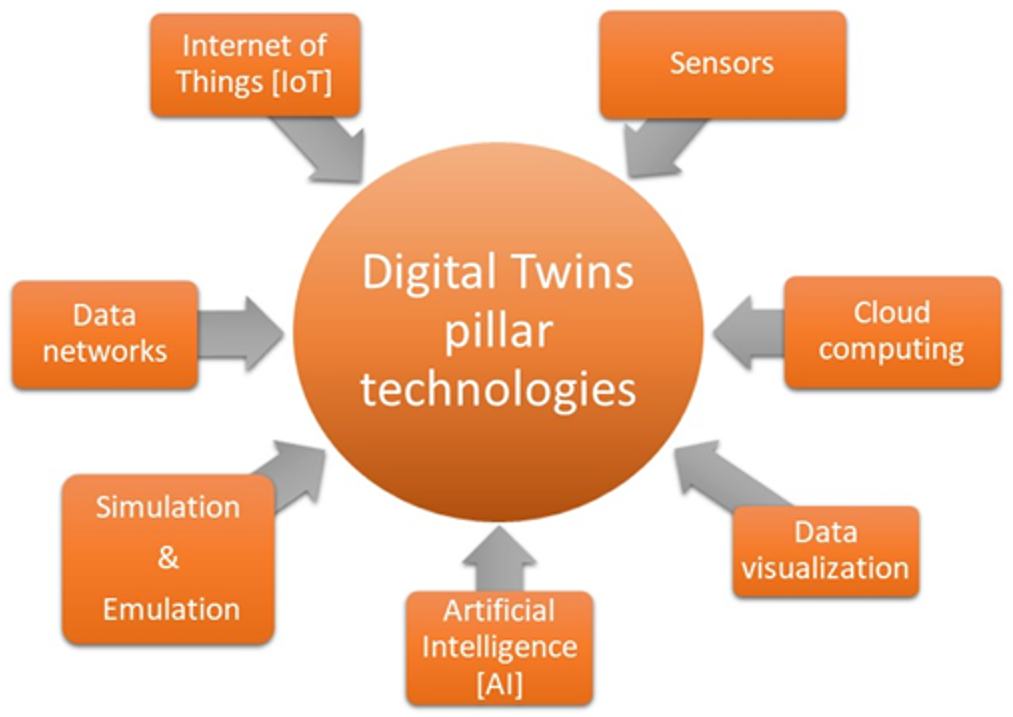
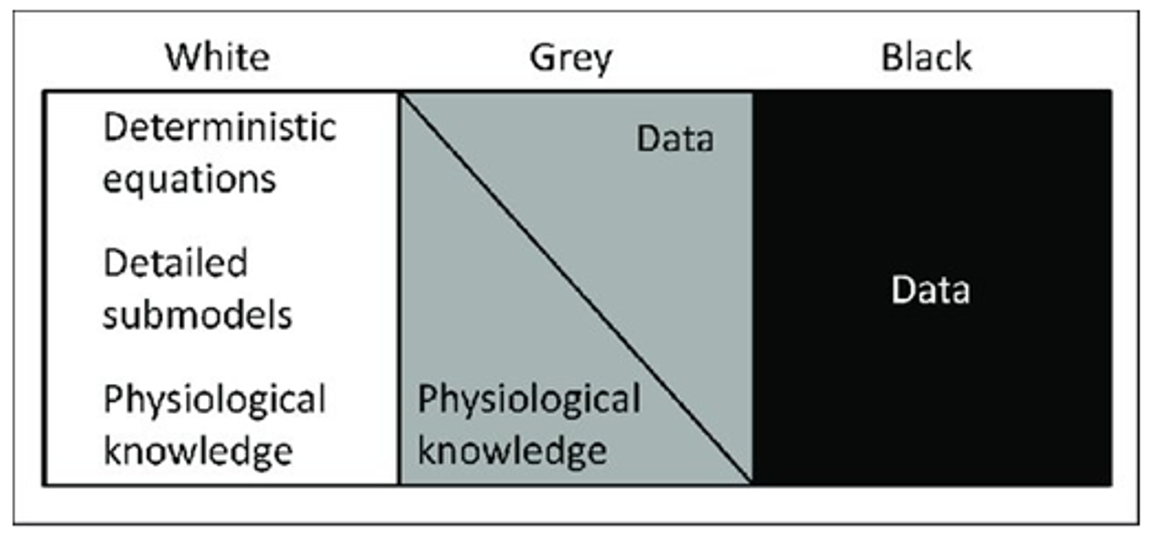
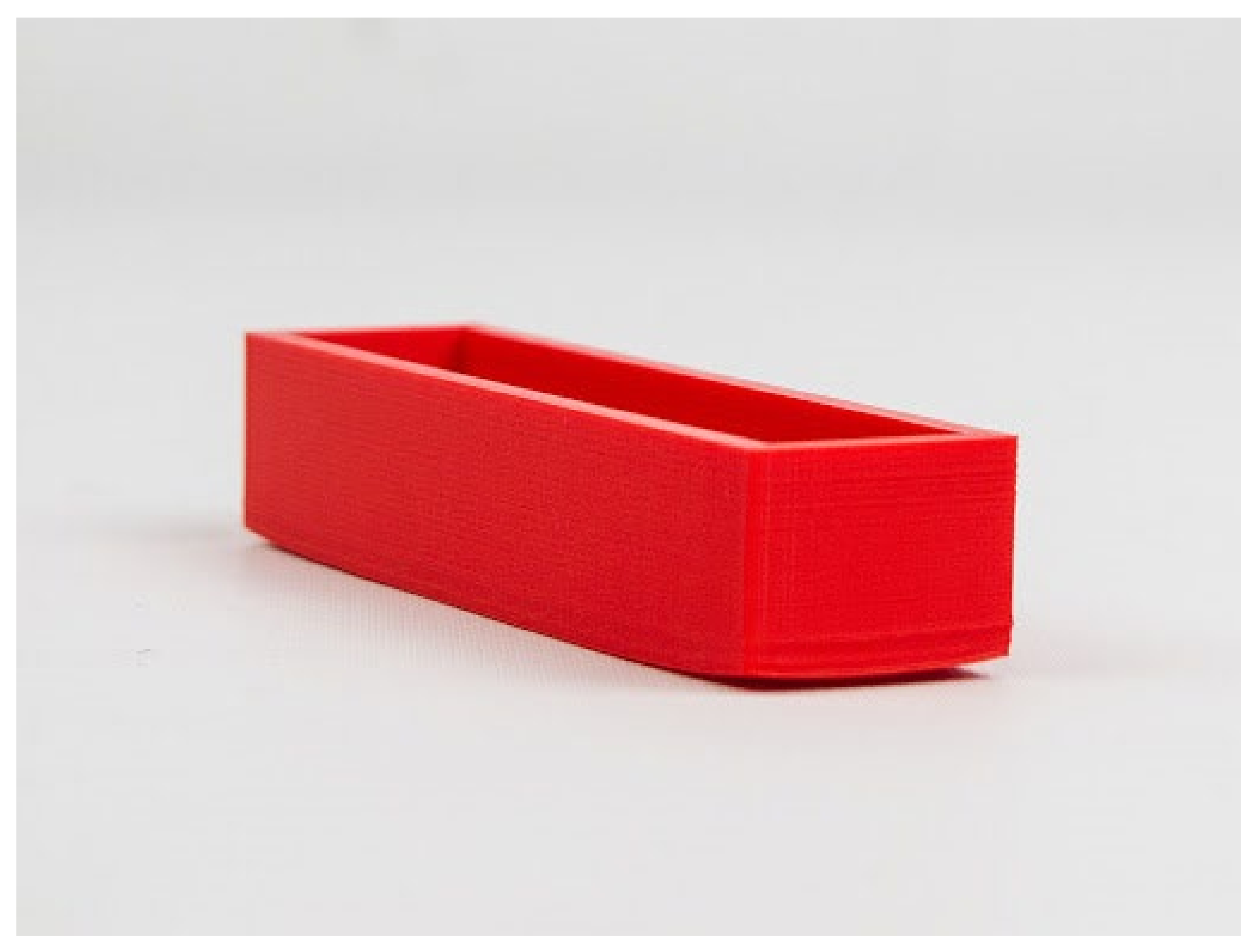
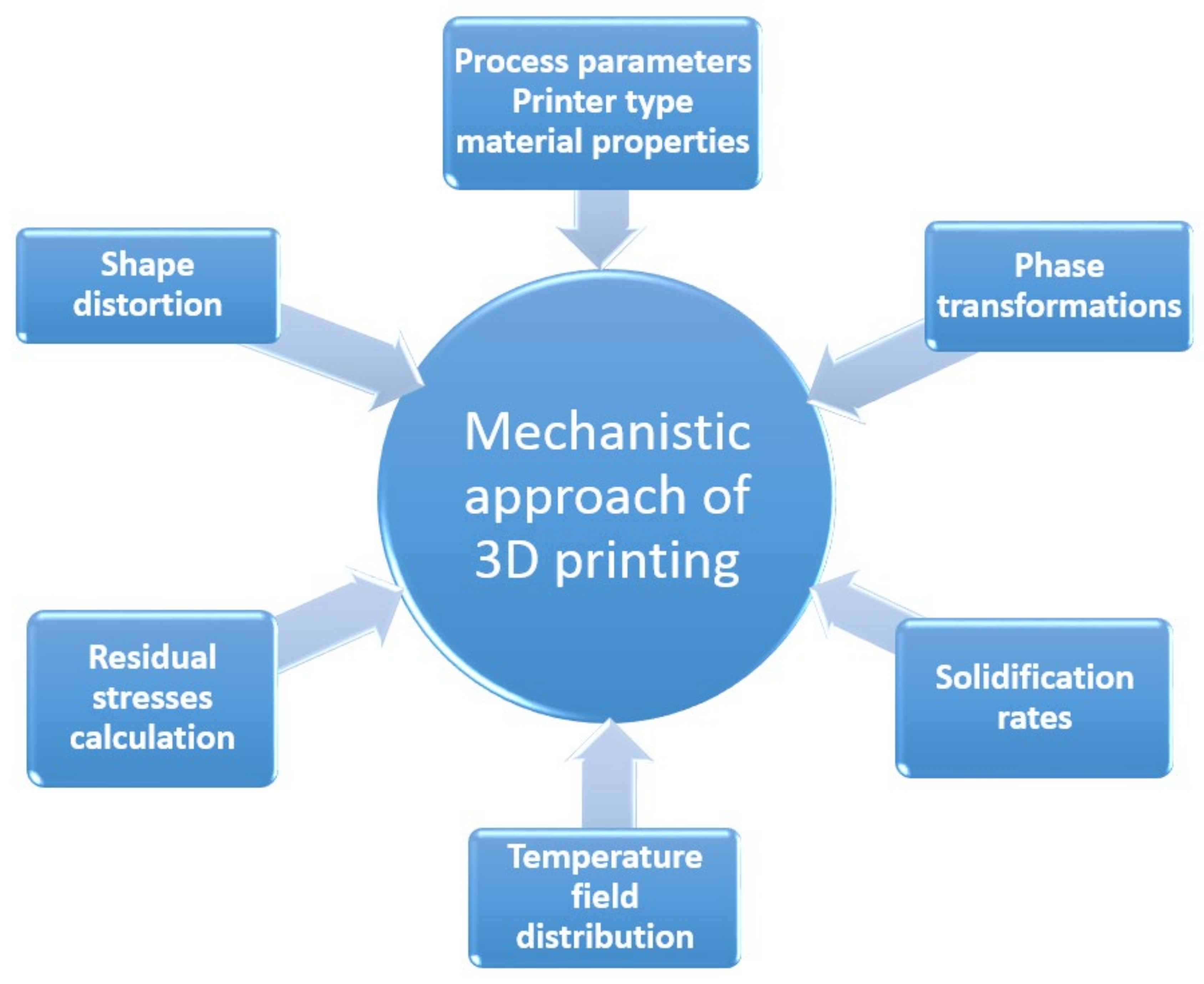
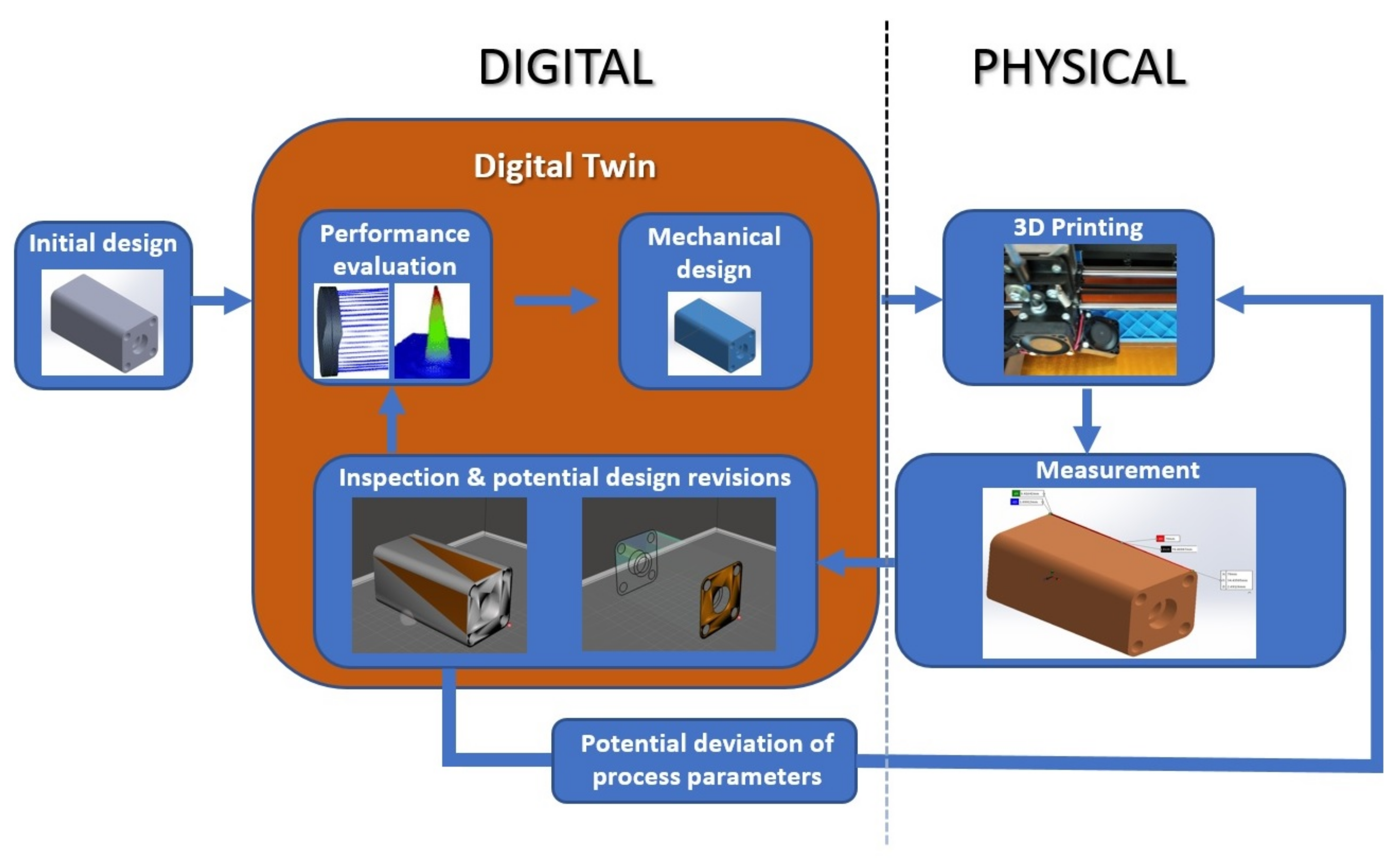
Publisher’s Note: MDPI stays neutral with regard to jurisdictional claims in published maps and institutional affiliations. |
© 2021 by the authors. Licensee MDPI, Basel, Switzerland. This article is an open access article distributed under the terms and conditions of the Creative Commons Attribution (CC BY) license (https://creativecommons.org/licenses/by/4.0/).
Share and Cite
Kantaros, A.; Piromalis, D.; Tsaramirsis, G.; Papageorgas, P.; Tamimi, H. 3D Printing and Implementation of Digital Twins: Current Trends and Limitations. Appl. Syst. Innov. 2022, 5, 7. https://doi.org/10.3390/asi5010007
Kantaros A, Piromalis D, Tsaramirsis G, Papageorgas P, Tamimi H. 3D Printing and Implementation of Digital Twins: Current Trends and Limitations. Applied System Innovation. 2022; 5(1):7. https://doi.org/10.3390/asi5010007
Chicago/Turabian StyleKantaros, Antreas, Dimitrios Piromalis, Georgios Tsaramirsis, Panagiotis Papageorgas, and Hatem Tamimi. 2022. "3D Printing and Implementation of Digital Twins: Current Trends and Limitations" Applied System Innovation 5, no. 1: 7. https://doi.org/10.3390/asi5010007
APA StyleKantaros, A., Piromalis, D., Tsaramirsis, G., Papageorgas, P., & Tamimi, H. (2022). 3D Printing and Implementation of Digital Twins: Current Trends and Limitations. Applied System Innovation, 5(1), 7. https://doi.org/10.3390/asi5010007








